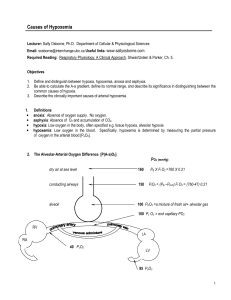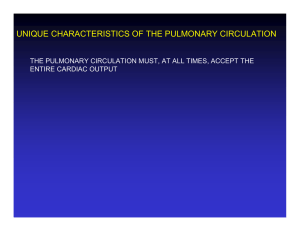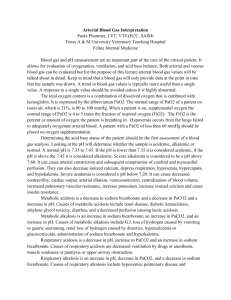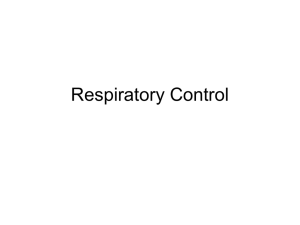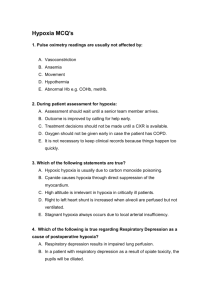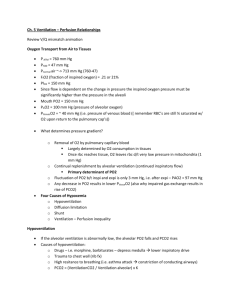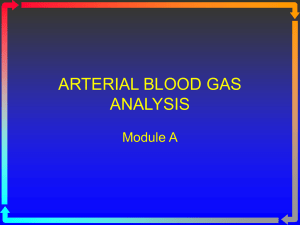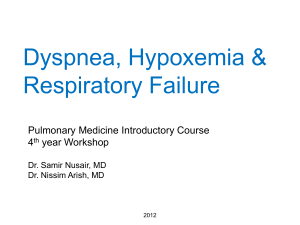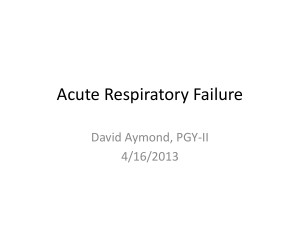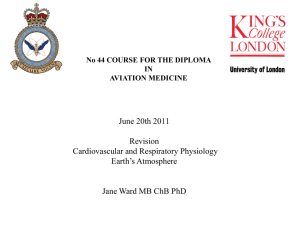Hypoxia - VCU Internal Medicine Electronic Residency Information
advertisement
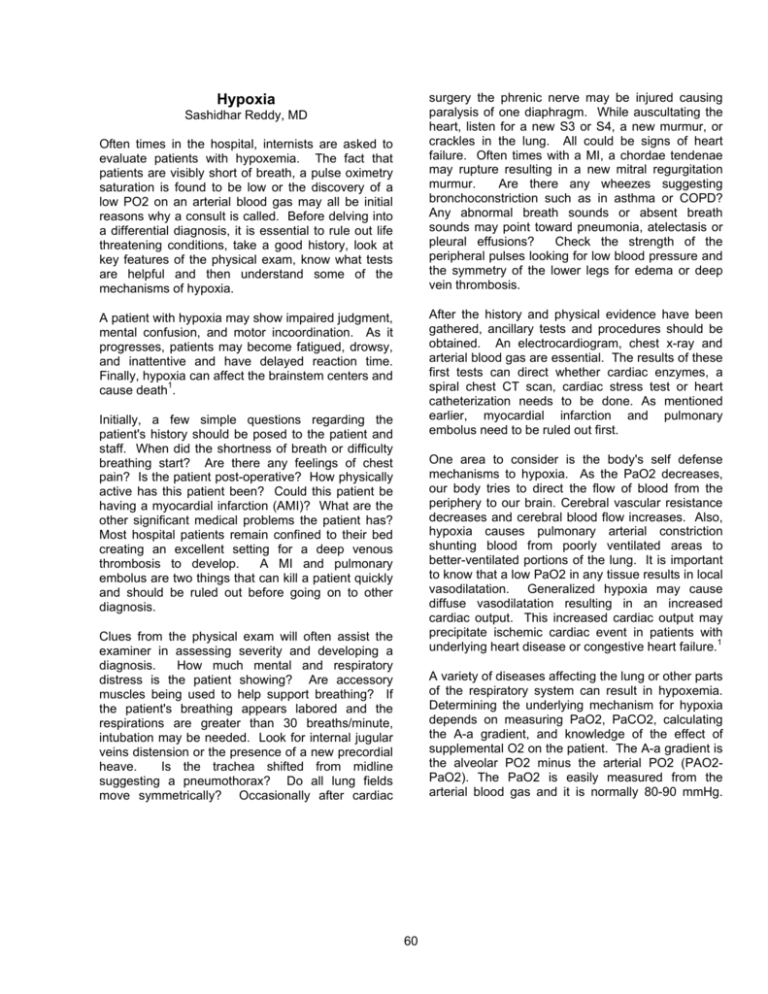
surgery the phrenic nerve may be injured causing paralysis of one diaphragm. While auscultating the heart, listen for a new S3 or S4, a new murmur, or crackles in the lung. All could be signs of heart failure. Often times with a MI, a chordae tendenae may rupture resulting in a new mitral regurgitation murmur. Are there any wheezes suggesting bronchoconstriction such as in asthma or COPD? Any abnormal breath sounds or absent breath sounds may point toward pneumonia, atelectasis or pleural effusions? Check the strength of the peripheral pulses looking for low blood pressure and the symmetry of the lower legs for edema or deep vein thrombosis. Hypoxia Sashidhar Reddy, MD Often times in the hospital, internists are asked to evaluate patients with hypoxemia. The fact that patients are visibly short of breath, a pulse oximetry saturation is found to be low or the discovery of a low PO2 on an arterial blood gas may all be initial reasons why a consult is called. Before delving into a differential diagnosis, it is essential to rule out life threatening conditions, take a good history, look at key features of the physical exam, know what tests are helpful and then understand some of the mechanisms of hypoxia. After the history and physical evidence have been gathered, ancillary tests and procedures should be obtained. An electrocardiogram, chest x-ray and arterial blood gas are essential. The results of these first tests can direct whether cardiac enzymes, a spiral chest CT scan, cardiac stress test or heart catheterization needs to be done. As mentioned earlier, myocardial infarction and pulmonary embolus need to be ruled out first. A patient with hypoxia may show impaired judgment, mental confusion, and motor incoordination. As it progresses, patients may become fatigued, drowsy, and inattentive and have delayed reaction time. Finally, hypoxia can affect the brainstem centers and cause death1. Initially, a few simple questions regarding the patient's history should be posed to the patient and staff. When did the shortness of breath or difficulty breathing start? Are there any feelings of chest pain? Is the patient post-operative? How physically active has this patient been? Could this patient be having a myocardial infarction (AMI)? What are the other significant medical problems the patient has? Most hospital patients remain confined to their bed creating an excellent setting for a deep venous thrombosis to develop. A MI and pulmonary embolus are two things that can kill a patient quickly and should be ruled out before going on to other diagnosis. One area to consider is the body's self defense mechanisms to hypoxia. As the PaO2 decreases, our body tries to direct the flow of blood from the periphery to our brain. Cerebral vascular resistance decreases and cerebral blood flow increases. Also, hypoxia causes pulmonary arterial constriction shunting blood from poorly ventilated areas to better-ventilated portions of the lung. It is important to know that a low PaO2 in any tissue results in local vasodilatation. Generalized hypoxia may cause diffuse vasodilatation resulting in an increased cardiac output. This increased cardiac output may precipitate ischemic cardiac event in patients with underlying heart disease or congestive heart failure.1 Clues from the physical exam will often assist the examiner in assessing severity and developing a diagnosis. How much mental and respiratory distress is the patient showing? Are accessory muscles being used to help support breathing? If the patient's breathing appears labored and the respirations are greater than 30 breaths/minute, intubation may be needed. Look for internal jugular veins distension or the presence of a new precordial heave. Is the trachea shifted from midline suggesting a pneumothorax? Do all lung fields move symmetrically? Occasionally after cardiac A variety of diseases affecting the lung or other parts of the respiratory system can result in hypoxemia. Determining the underlying mechanism for hypoxia depends on measuring PaO2, PaCO2, calculating the A-a gradient, and knowledge of the effect of supplemental O2 on the patient. The A-a gradient is the alveolar PO2 minus the arterial PO2 (PAO2PaO2). The PaO2 is easily measured from the arterial blood gas and it is normally 80-90 mmHg. 60 The PAO2 is calculated as follows: PAO2= FIO2 * (Barometric Pressure - Partial Pressure of H2O vapor) - PaCO2/respiratory quotient PAO2= FIO2 * (713)- PaCO2/(0.8) = 0.21*(713) - PaCO2/(O.8) =150 - PaCO2/(0.8) A-a gradient= PAO2 – PaO2 The FIO2 in the example above was assumed to be 0.21. Therefore, the variable needed to calculate PAO2 is the PaCO2, which is easily measured from the arterial blood gas. The normal A-a gradient is 10-20. Note that if a patient is on supplemental O2 then the PAO2 will increase.2 This then raises the normal A-a gradient. Causes of Hypoxemia5 Causes PAO2 – PaO2 Response to 100% O2 PaCO2 Low PIO2 Normal Increased Normal V/Q mismatch Increased Increased Normal Shunt Increased No improvement Normal Hypoventilation Normal Increased Increased Causes of Alveolar Dead Space Ventilation4 Venous Thrombosis Pulmonary Embolus Amniotic Fluid Carbon Dioxide (after laproscopic surgery) Fat (after orthopedic surgery) Decreased Pulmonary Artery Pressure Decreased Cardiac output (hypovolemia, CHF) Nondependent lung region (sitting position) Increased Alveolar Gas Pressure Positive end-expiratory pressure (PEEP) Large Tidal Volume Over distension of Alveoli COPD 61 that does not exchange fully with capillary blood. This is excess ventilation relative to capillary perfusion. An increase in dead space produces both hypoxia and hypercapnia. Furthermore, the O2 in arterial blood is the sum of the O2 in mixed venous blood (pulmonary artery) and the O2 added from the alveolar gas. With normal lung function, alveolar O2 is the major determinant of PaO2. With impaired gas exchange, alveolar O2 contributes less and the mixed venous O2 contributes more to the PaO2. There are four basic mechanisms of hypoxia. Shunting occurs when desaturated blood effectively bypasses oxygenation at the alveolar capillary level. Structural problems allow desaturated blood to bypass the site of gas exchange and perfused alveoli are not ventilated. As venous admixture increases, it behaves like a true shunt. Most commonly this is caused by alveoli that are atelectatic or fluid filled (pulmonary edema) or by extensive alveolar exudate secondary to pneumonia. Less common causes include arterial venous shunting. In pulmonary edema and pulmonary embolus, the gas exchange abnormality behaves more like a true shunt. In pulmonary embolus, the shunt is the result of diversion of blood away from the embolized region and overperfusion of the remainder of the lung.3 1. Decreased inspiratory PO2 2. Ventilation (V) / Perfusion (Q) mismatch 3. Shunting 4. Hypoventilation. Decreased inspiratory PO2 (PIO2) rarely occurs in the hospital setting but it is an important mechanism that should not be ignored. The patient basically breathes in a decreased amount of oxygen. Possible causes include a high altitude setting or breathing in a gas mixture containing <21%O2. The latter may occur in a patient receiving anesthesia, ventilator support or during smoke inhalation. With this mechanism, gas exchange at the alveolar capillary level occurs normally and the A-a gradient is normal.3 In V/Q mismatch, there is an increased A-a gradient and a normal PCO2. Supplemental O2 helps correct the hypoxia in V/Q mismatch but not resulting from a shunt (Figure 1). V/Q mismatch is the most common cause of hypoxemia clinically. The ratio of alveolar ventilation to capillary perfusion ideally is 1:1. Diseases affecting the airway or the pulmonary parenchyma are distributed unevenly throughout the lung and do not affect ventilation or perfusion equally. Some areas may have a high V/Q ratio producing blood with a high PO2 and higher O2 content. Other regions have a low V/Q ratio producing blood with a low PO2 and lower O2 content. Dead space ventilation is lung area that does not participate in gas exchange and causes a V/Q ratio >1. Physiologic dead space is the excess alveolar gas An increased PaCO2 always accompanies hypoventilation. If the A-a gradient is normal, then it is most likely secondary to a central neurologic cause. If the A-a gradient is increased, then a concomitant ventilation perfusion abnormality exists. Furthermore, supplemental O2 will improve PaO2 in patients with hypoventilation.5 Investigating the cause for hypoxia can be challenging with many possibilities existing. Following a logical pathway that starts with a good history and physical examination will point the examiner in the right direction. After understanding the mechanism of hypoxia a differential diagnosis can be formulated. Causes of Alveolar Hypoventilation Brainstem Depression Opiates, lidocaine Muscle Weakness Shock or low flow states, sepsis, decreased phosphorous or magnesium Neurologic Problems Phrenic nerve injury from cardiac surgery, Myasthenia gravis, Guillian Barre syndrome, neuropathy of critical illness Idiopathic Obesity, Sleep Apnea 62 Figure 13 Yes Is the PaCO2 increased? No Is PAO2-PaO2 increased? Hypoventilation Yes No Decreased Inspired PO2 Is low PO2 correctable with O2? Is PAO2-PaO2 increased? No No Hypoventilation alone Yes Hypoventilation plus another mechanism 1. ↓ Respiratory Drive 2. Yes 1. 2. Neuromuscular disease 3. 4. Shunt V/Q mismatch Alveolar collapse (atelectasis) Intraalveolar filling (pneumonia, pulmonary edema) Intracardiac shunt Vascular 1. shunt within lungs References 1. Braunwald "Hypoxia and Cyanosis", Harrison's Principles of Internal Medicine 15th edition. McGrawHill, 2001, pp. 214-16 2. Marino. The ICU Book. Lea and Febiger 1991: 2536 3. Weinberger, Drazen "Disturbances of Respiratory Function", Harrison's Principles of Internal Medicine 15th edition. McGraw-Hill, 2001, pp.1446-53 4.Breen,"Arterial Blood Gas and pH Analysis", Anesthesiol Clin N Amer 2001; 19, No. 4 5. Wilson and Shapiro, “Perioperative Hypoxia”, Anesthesiol Clin N Amer 2001; Vol. 19, No. 4. 63 2. 3. 4. Airways disease (asthma, COPD) Interstitial lung disease Alveolar disease Pulmonary vascular disease 1. High altitude 2. ↓ FIO2
